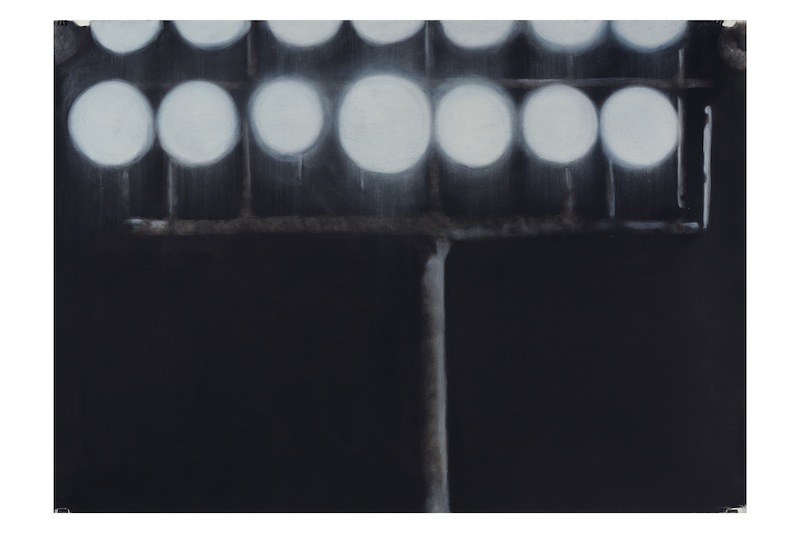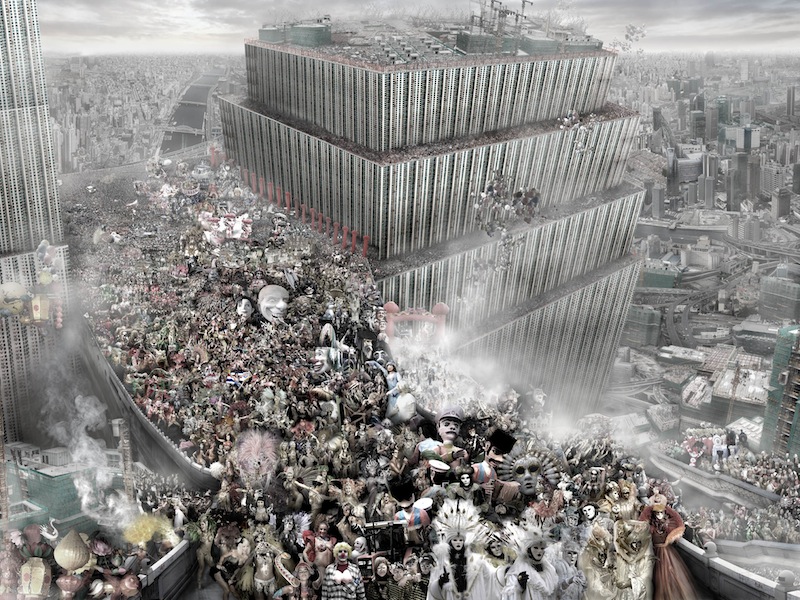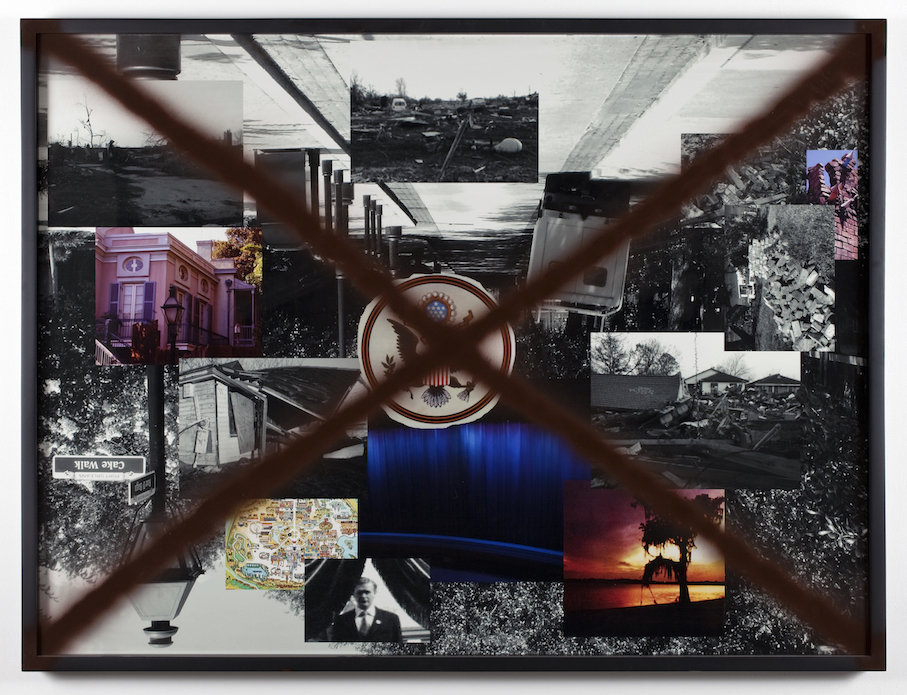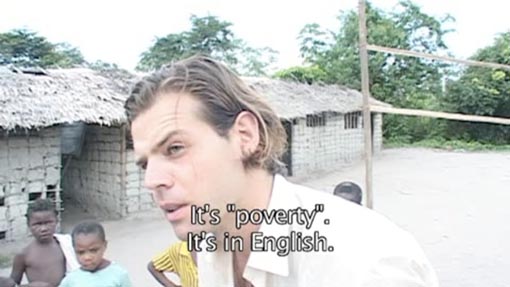
© » KADIST
Bontaro Dokuyama
In Over There, Bontaro Dokuyama conducted a series of workshops with various people who had been forced to relocate in temporary housing after the Fukushima accident. Participants in the workshop made masks from local newspaper cuttings, included in the installation as well as videos showing these different persons wearing their masks, pointing in the direction of their hometowns, where they can no longer return. Over There portrays those displaced from Fukushima due to the 2011 nuclear disaster, underlining the subjectivity of each person in opposition to the way they are usually considered within the Japanese society or by the media, calling them “victims from the disaster.”

© » KADIST
Hikaru Fujii
The film The Anatomy Classroom is part of a research project developed by Hikaru Fujii around objects and artifacts evacuated from the Futaba Town Museum of History and Folklore, which is located in the “difficult-to-return zone” since the Fukushima Daiichi nuclear accident. In order to avoid radioactive contamination and biological damage, the objects have been removed from the museum, where they were once part of a collection that the curator had developed over twenty years to represent the local community and its long history on the land. Fujii has been closely following the movements of these historical objects, while organizing visits to the site and hosting discursive events on the crisis of memory and culture.

© » KADIST
Noémie Goudal
Noémie Goudal’s short film, Below the Deep South , is based on the work of palaeoclimatologist James Bendle who, while drilling in Antarctica, discovered coal beneath the ice. Bendle’s theory is that the coal is an indication that Antarctica was once a lush, green forested environment with insects and animals. It only arrived in its present position due to the shifting of tectonic plates.

© » KADIST
Mikhael Subotzky
At the halfway point along South Africa’s Highway N1, running from Cape Town to Johannesburg, sits the small town of Beaufort West. The 1,200-mile highway joins the northern provinces of the country to the south cuts through. Beaufort West becomes the main strip of the township, whereby the thousands of commuters passing through are thus forced to witness the town’s squalid social and economic condition.

© » KADIST
Joana Hadjithomas & Khalil Joreige
Produced for the Prix Marcel Duchamp and presented at the Centre Pompidou in October 2017, the installation Unconformities is comprised of photographs, archaeological drawings, and narratives, based on the analysis of core samples from different sites in Beirut, Paris and Athens. The work questions how, at a time when traces and memories no longer exist, and the earth remains the only witness of our past, history is produced, and how the stories of our civilization are written and told. In each location, the artists collected soil samples, which they asked experts to analyze before creating a series of narrations and coded drawings.

© » KADIST
Ana Vaz
Ana Vaz describes her film É Noite na América (It is Night in America) as an eco-terror tale, freely inspired by A cosmopolitics of animals by Brazilian philosopher Juliana Fausto; in which she investigates the political life of non-human beings and questions the modern idea of the exceptionality of the human species. In parallel to the feature film version, Vaz created a three-channel installation format meant to be displayed in contemporary art spaces. This edition includes three complementary video works that expand on the conceptual frameworks of the film.

© » KADIST
Chitra Ganesh
Silhouette in the Graveyard is part of a suite of animated videos by Chitra Ganesh titled The Scorpion Gesture . All five videos incorporate figures and themes from Buddhist mythology and dialogue directly with artworks from the Rubin Museum, for which the videos were originally produced.? The central figure of Silhouette in the Graveyard is Maitreya, the Future Buddha, whose arrival on Earth was prophesied to usher in a new age.

© » KADIST
Joana Hadjithomas & Khalil Joreige
Produced for the Prix Marcel Duchamp and presented at the Centre Pompidou in October 2017, the installation Uncomformities is comprised of photographs, archaeological drawings, and narratives, based on the analysis of core samples from different sites in Beirut, Paris and Athens. The work questions how, at a time when traces and memories no longer exist, and the earth remains the only witness of our past, history is produced, and how the stories of our civilization are written and told. In each location, the artists collected soil samples, which they asked experts to analyze before creating a series of narrations and coded drawings.

© » KADIST
Gozo Yoshimasu
Drawing & Print (Drawing & Print)
Gozo Yoshimasu’s visual-poetry series Dear Monster (Kaibutsu-kun) explores his response to the March 2011 Tohoku earthquake and tsunami. He embarked on the project out of a deep sense of sympathy and commitment, in pursuit of “poetry possible after March 2011”, without exactly knowing where he was heading. He started scribing lines and letters on exceptionally large manuscript paper that he handcrafted every day.

© » KADIST
Haig Aivazian
Drawing & Print (Drawing & Print)
This work is part of an ongoing project that looks at international sports competitions as a revealing element of nationalistic aspirations which present contradictions. The starting point of this work was inspired by private companies which were responsible for the security of the Olympic Games in England and also supply equipment for immigrant detention camps and prisons. This work questions the use of the stadiums other than for sports competitions.

© » KADIST
Prabhakar Pachpute
“Dark Clouds Of The Future” is a cinematographic video animation of the abandoned gold mine in Brazil, Serra Pelada (“Naked Mountain”). Thought to be one of the largest mines in the world, made famous by the photographs Alfredo Jaar and later by Sebastião Salgado, the hand-dug mine is now a mercury-polluted lake. During his research trip to Brazil, Pachpute met many former gold diggers who used to work at Serra Pelada, inciting his interest in the concept of the witness.

© » KADIST
Rachel Rose
A minute Ago starts with a hailstorm pelting down unexpectedly on a quiet beach in Siberia. People, half naked, run for cover under towels and parasols, to the music of the Pink Floyd. The next scene is an interview of Philip Johnson, filmed 10 years before in the Glass House he constructed.

© » KADIST
Naoya Hatakeyama
Naoya Hatakeyama’s series Rikuzentakata (2011) documents the devastating aftermath of the 2011 Tohoku earthquake and tsunami in Japan. Throughout the series of sixty C-prints, Hatakeyama’s photographs depict scenes of torn landscapes and leveled homes, demolished villages and massive piles of detritus pummeled beyond recognition. The images serve as records of disaster, seemingly driven by an intense need to bear witness to collective trauma.

© » KADIST
Du Zhenjun
The Tower of Babel is an installation of large-format photographs that forces the audience to occupy a central position through its monumental scale. These photographs present a series of urban landscapes and assembled Foucauldian structures of the present. Du sees the Tower of Babel as a continually reinvented narrative that warns people of “dangerous tendencies in the present time.” Du’s Babylonian towers resurrect from fallen rubbles of religious history in grand scale to focus on modern crises of civilization.

© » KADIST
Du Zhenjun
The Tower of Babel is an installation of large-format photographs that forces the audience to occupy a central position through its monumental scale. These photographs present a series of urban landscapes and assembled Foucauldian structures of the present. Du sees the Tower of Babel as a continually reinvented narrative that warns people of “dangerous tendencies in the present time.” Du’s Babylonian towers resurrect from fallen rubbles of religious history in grand scale to focus on modern crises of civilization.

© » KADIST
Stephen G. Rhodes
For his series of digital collages Excerpt (Sealed)… Rhodes appropriated multiple images from mass media and then sprayed an X on top of their glass and frame. This visual seal refers to the disastrous aftermath of Hurricane Katrina in 2005 in which rescue workers spray painted the doors of the houses they searched giving the date, the team and the number of bodies found. Excerpt (Sealed) (Brown) is a multilayered collage with contradictory imagery—from New Orleans debris to the American eagle and a theater curtain.
Joana Hadjithomas & Khalil Joreige
Joana Hadjithomas and Khalil Joreige collaborate as both filmmakers and artists, producing cinematic and visual artwork that intertwine, spanning feature and documentary films, video and photographic installations, sculpture, performance lectures and texts...
Du Zhenjun
- location: Paris, France
- location: Shanghai, China
- year born: 1961
- gender: male
- nationality: Chinese
- home town: Shanghai, China
Rachel Rose
Rachel Rose is a visual artist known for her video installations that merge moving images and sound within nuanced environments connecting them to broader subjects...
Bontaro Dokuyama
Bontaro Dokuyama became an artist after the triple disaster of March 2011 that irrevocably damaged his hometown of Fukushima, “sensing that everything that had been taught to him was a lie.” Previously working as an architect, he then started his artistic practice under a new name in order to underline the beginning of this new life...
Gozo Yoshimasu
Gozo Yoshimasu is a prolific Japanese poet, photographer, artist and filmmaker active since the 1960s...
Hikaru Fujii
Hikaru Fujii utilizes film to bridge art and social activism...
Chitra Ganesh
Spanning printmaking, sculpture, and video, Chitra Ganesh’s work draws from broad-ranging material and historic reference points, including surrealism, expressionism, Hindu, Greek and Buddhist iconographies, South Asian pictorial traditions, 19th-century European portraiture and fairy tales, comic books, song lyrics, science fiction, Bollywood posters, news and media images...
Mikhael Subotzky
Mikhael Subotzky’s (b...
Naoya Hatakeyama
- location: Iwate, Nihon
- year born: 1958
- gender: male
- nationality: Japanese
Ana Vaz
Ana Vaz is an artist and filmmaker whose works speculate on the relationships between self and other, and myth and history, through a cosmology of signs, references, and perspectives...
Prabhakar Pachpute
Prabhakar Pachpute calls attention to issues concerning land politics, industry, and labor through a multimedia practice that includes drawing, painting, sculpture, animation, and murals...
Stephen G. Rhodes
- location: New York, New York
- year born: 1977
- gender: male
- nationality: American
- home town: Houston, Texas
Haig Aivazian
Haig Aivazian is an artist and a writer, born in 1980 in Beirut and currently based there...
-
2000-2009
Mikhael Subotzky
2006At the halfway point along South Africa’s Highway N1, running from Cape Town to Johannesburg, sits the small town of Beaufort West...
-
2010-2019
Du Zhenjun
2010The Tower of Babel is an installation of large-format photographs that forces the audience to occupy a central position through its monumental scale...
Du Zhenjun
2010The Tower of Babel is an installation of large-format photographs that forces the audience to occupy a central position through its monumental scale...
Stephen G. Rhodes
2010For his series of digital collages Excerpt (Sealed)… Rhodes appropriated multiple images from mass media and then sprayed an X on top of their glass and frame...
Haig Aivazian
Drawing & Print
2013(Drawing & Print) This work is part of an ongoing project that looks at international sports competitions as a revealing element of nationalistic aspirations which present contradictions...
Gozo Yoshimasu
Drawing & Print
2014(Drawing & Print) Gozo Yoshimasu’s visual-poetry series Dear Monster (Kaibutsu-kun) explores his response to the March 2011 Tohoku earthquake and tsunami...
Prabhakar Pachpute
2014“Dark Clouds Of The Future” is a cinematographic video animation of the abandoned gold mine in Brazil, Serra Pelada (“Naked Mountain”)...
Rachel Rose
2014A minute Ago starts with a hailstorm pelting down unexpectedly on a quiet beach in Siberia...
Bontaro Dokuyama
2015In Over There, Bontaro Dokuyama conducted a series of workshops with various people who had been forced to relocate in temporary housing after the Fukushima accident...
Joana Hadjithomas & Khalil Joreige
2017Produced for the Prix Marcel Duchamp and presented at the Centre Pompidou in October 2017, the installation Unconformities is comprised of photographs, archaeological drawings, and narratives, based on the analysis of core samples from different sites in Beirut, Paris and Athens...
Joana Hadjithomas & Khalil Joreige
2017Produced for the Prix Marcel Duchamp and presented at the Centre Pompidou in October 2017, the installation Uncomformities is comprised of photographs, archaeological drawings, and narratives, based on the analysis of core samples from different sites in Beirut, Paris and Athens...
Chitra Ganesh
2018Silhouette in the Graveyard is part of a suite of animated videos by Chitra Ganesh titled The Scorpion Gesture ...
-
2020-2029
Hikaru Fujii
2020The film The Anatomy Classroom is part of a research project developed by Hikaru Fujii around objects and artifacts evacuated from the Futaba Town Museum of History and Folklore, which is located in the “difficult-to-return zone” since the Fukushima Daiichi nuclear accident...
Noémie Goudal
2021Noémie Goudal’s short film, Below the Deep South , is based on the work of palaeoclimatologist James Bendle who, while drilling in Antarctica, discovered coal beneath the ice...
Ana Vaz
2022Ana Vaz describes her film É Noite na América (It is Night in America) as an eco-terror tale, freely inspired by A cosmopolitics of animals by Brazilian philosopher Juliana Fausto; in which she investigates the political life of non-human beings and questions the modern idea of the exceptionality of the human species...








